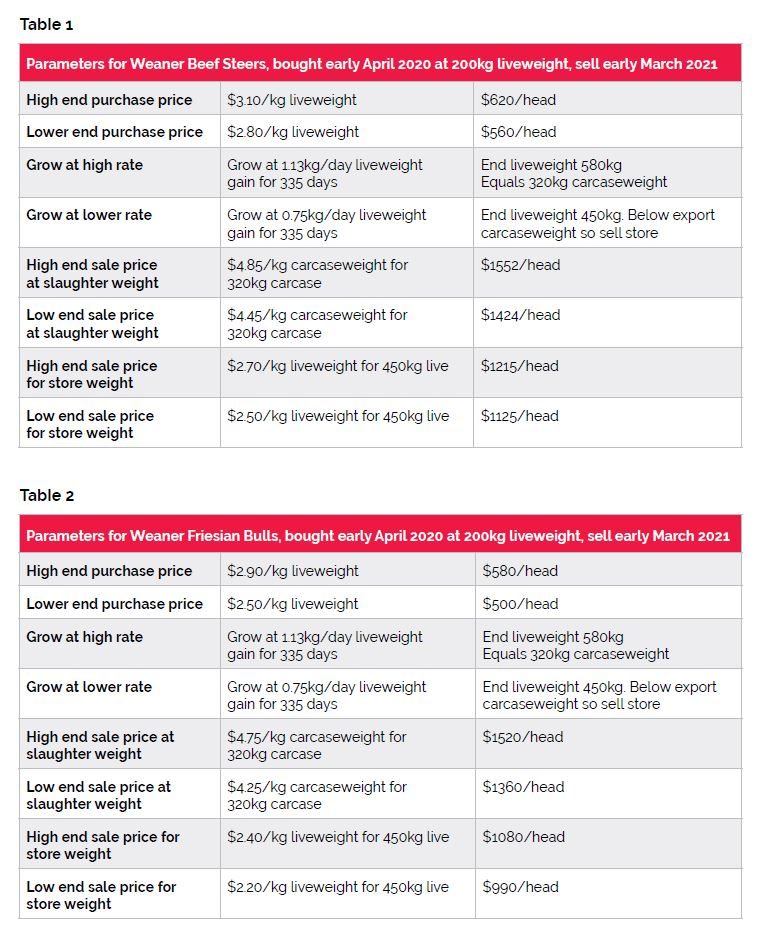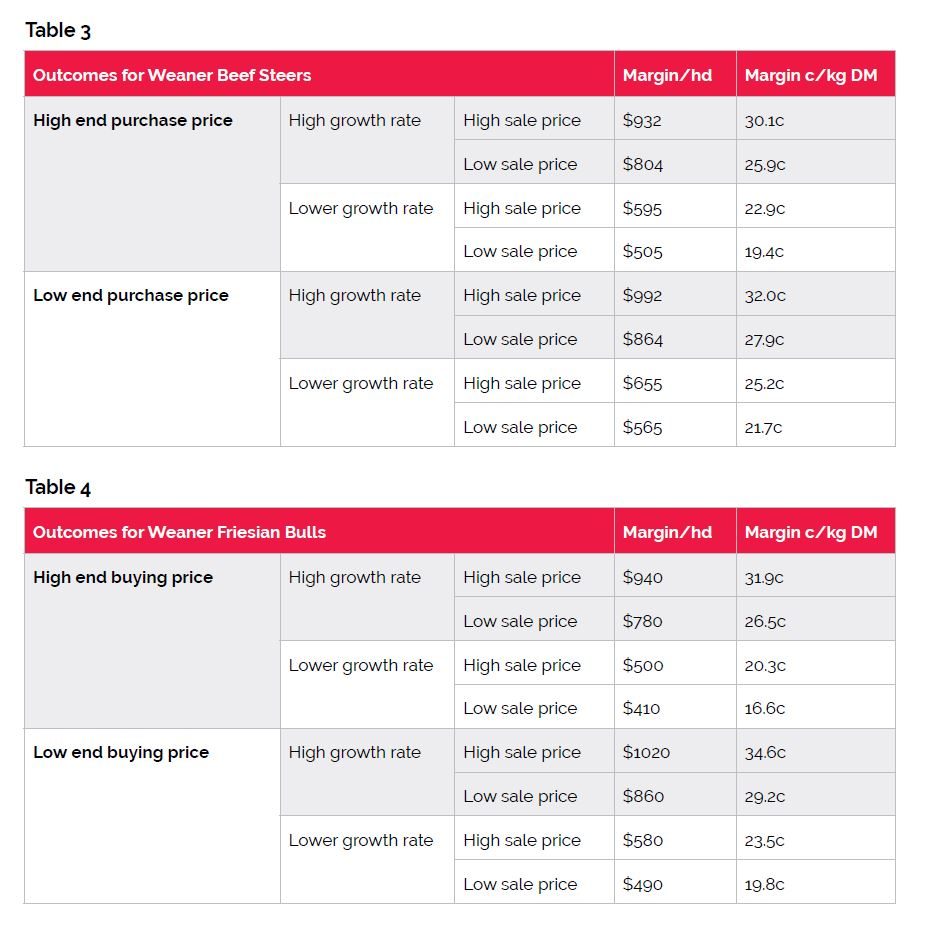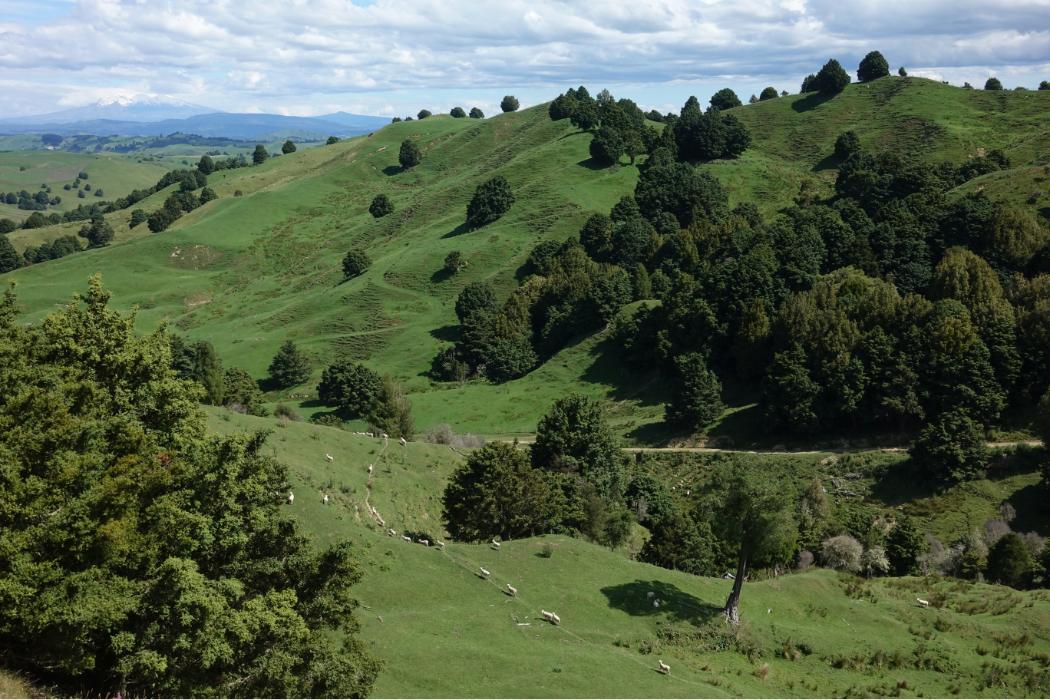There are many variables when trading and finishing livestock. Kerry Dwyer crunches the numbers to see how you can get more bang for your buck.
Looking at various enterprise options it is easy to look at an average return from any business. However, as the song goes “It ain’t what you do, it’s the way that you do it, and that’s what gets results.” This approach is better than looking at averages for most situations.
We can look at a couple of beef finishing options. The simple options are buying either weaner beef steers or Friesian bull calves in early April, and selling the following March. That allows a month for some pasture growth before the next batch arrives, and a total change over comparing apples with apples. The previous batch is sold regardless of weight but as slaughter or store propositions. I have used prices for 2020 and 2021 to make it a real summary of the last 12 months. Also, to compare apples with apples, let’s keep the purchase and sale weights the same for steers and bulls.
The biggest variables in trading and finishing livestock are:
- Purchase price
- Growth rates achieved
- Sale price.
The purchase price will vary with private versus auction sale, between regions and times. I have taken a spread of 30c/kg liveweight for the beef steers and 40c/kg for the bulls. In some cases you will see a bigger variation.
Growth rate achieved has a huge impact on this scenario, because a fast growing steer or bull will make a good slaughter weight at 18 months of age while a slower growing animal will be a store market proposition at the same age. I have calculated a fast liveweight growth rate of 1.13kg/day average is needed to take a 200kg calf in April to 580kg liveweight the following March. A lower growth rate of 0.75kg/day results in a 450kg animal that fits the store market rather than slaughter.
Sale price varies by 40-50c/kg carcaseweight for slaughter animals and by at least 20c/kg liveweight for store sales. There is a large gap between published schedule prices and the top margin paid for slaughter beef, depending on business relationships and regions. Here in the South Island, we are constantly irritated to see our co-operatives pay more in the North Island for similar animals.
Tables 1 and 2 show the options all being put together: buying at two different levels, and then growing the animals at two different levels to give four different sale results.

The range of results for the steers is $1125-$1552/head gross sale value. You might deduct some costs from these values because I have not allowed for cartage, animal health, interest and other factors. However, the point is clear that you will get a range of profit margins as a result of the differences in gross sale value.
The bulls show a range of $990-$1520/hd gross. Growing a steer on a slower rate is more profitable than a slow growing bull because bulls typically have a lower store value than steers, which tends to be extended at autumn sales.
Tables 3 and 4 show the differing margins achieved, given the variations in purchase price, growth rate and sale prices.
The steers show a margin range of $505-992/hd while the bulls range $490-1020/hd.

In terms of the per head margin there is no clear cut difference between steers and bulls, it is the other variables that dictate which is the most profitable option.
To calculate the per kg drymatter return, I have estimated that a steer requires 3100kg DM to grow from 200kg to 580kg liveweight in 335 days at the high growth rate average of 1.13kg/day. The slower growing steer eats 2600kg DM by comparison. The research shows bulls will eat about 5% less to achieve the same growth rates, so 2950kg DM for the faster growing bull and 2470kg DM for the slower growth rate.
The steers show a range of return per kg DM eaten of 19.4-32c while the bulls range 16.6-34.6c.
Return on investment
Let’s split the results down a bit more, we can look at the average returns according to the three variables of purchase price, growth rate and sale price. The more expensive steers give a 4% lower return than the cheaper steers, while the bulls show an 11% advantage to the lower purchase price.
The difference in return per c/kg DM between high and lower growth rates is 23% in steers and 35% in bulls. How you grow them is by far the most important factor in beef finishing profitability. In this analysis, the difference between selling slaughter weight cattle versus stores is a difference of $300-$400/hd, a margin of over 60c/kg DM for the additional feed input to get them from store to slaughter weight in the allowed time.
The difference in return per c/kg DM between high and lower sale prices is 14% in steers and 17% in bulls.
Buying right is important. Most important is to grow them well, and finish the job with a good sale price.
- Kerry Dwyer is a North Otago farm consultant and farmer.




